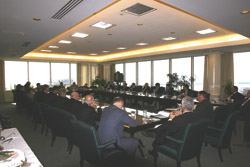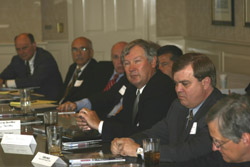
Kim Jones of Blackwell Sanders Peper Martin spoke of her involvement with the Kansas City Minority Bar Association (KCMBA) on an upcoming job fair designed to bring more and diverse attorneys to the area.
Others were involved with the KCMBA as well. Bill Carr of Lewis Rice & Fingersh, for instance, cited his participation in the drafting of its diversity plan. Tom Rice and his whole firm—Baker Sterchi Cowden & Rice—got behind the diversity movement, establishing partnerships with the KCMBA.
Tom Stewart of Lathrop & Gage pointed to his fundraising activities with the job fair as one of his more successful civic ventures in the past year, that and his role in the consolidation of the area’s various United Funds. Carl Helmstetter’s contribution to making Kansas City “a vibrant and diverse cultural community” was to lend his counsel to Kansas City artists and filmmakers.
Jennifer Gille Bacon of Shughart Thomson & Kilroy involved herself in the Missouri Bar, chairing its multi-jurisdiction practice subcommittee. Dave Fenley of Blackwell Sanders worked in Missouri with the legislature and the governor’s office, including work on a new jobs program and legislation that corrected problems with state’s supplemental TIF program.
Joe Hiersteiner of Seigfreid Bingham Levy, Selzer & Gee noted his and his firm’s activity in fundraising and governance issues at Truman Medical Center, specifically the behavioral health aspects of Truman. For Peter Brown of Husch & Eppenberger, satisfaction came through his work with Barnett Helzberg’s Charter School, University Academy. It will “do a huge amount of good for education in the city,” said Brown.
John Murphy of Shook, Hardy & Bacon spoke of his work with Starlight, the Chamber and the Catholic Education Foundation. Russ Welsh of Polsinelli Shalton Welte Suelthaus has served on the board of the Kansas City Area Development Council and participated personally and through the firm in helping to bring new businesses to Kansas City.
Not intending to be at all flippant, Steve Brown of Brown & Dunn “rode the MAX to work.” The MAX is the metro area express, the KCATA’s improved bus service. Brown found the range of people who take this bus “astounding.”
“This a great time to practice law in Kansas City,” argued Mike Burke of King Hershey. “There is a lot going on,” As Chair of the Public Improvement Advisory Committee, Burke has helped make much of this transpire, having approved close to $300 million in capital improvements hopefully in two years.
Kansas City attorneys like Burke have been lending their talents to the government at the local, state and federal levels. Cathy Dean of Polsinelli Shalton Welte Suelthaus has been working with the Missouri State Government Review Commission. She is one of 20 people taking testimony and reviewing every executive department within state government to identify opportunities to restructure, retool or eliminate functions in accordance with what will result in the most cost-effective service for Missouri citizens. Mitch Woolery of Kutak Rock considers himself an “evangelist” for the new market tax credit program, a billion dollar federal program that he hopes to see allocate funds to Kansas or Kansas City.
Other Kansas City attorneys have helped advance the well-being of the community in a variety of distinctive ways. Brian Finucane, whose firm, Fisher & Phillips, represents management in labor-employer matters, has been encouraging clients to establish arbitration policies to take suits out of expensive courtroom settings and into a more efficient arbitration process. Similarly, Kent Sullivan felt privileged to serve more as a mediator than as a litigator. "I feel good about my work in that area,” he observed.
Anita Porte Robb of Robb & Robb, a trial law firm, spends more time “talking people out of filing law suits than probably anyone at this table.” Dennis Honobach and the Washburn University Law School have aspired to train lawyers who are “transactionally capable” by instituting a “business camp,” a program that gives students real experience in finance and accounting from a business perspective. For his part, Jim Sanders of Wallace Sanders Austin Brown & Enoch published a mediation and arbitration listing/handbook.
Ed Spalty of Armstrong Teasdale served as a director of a national healthcare charity and in that role was able to work out an agreement with local affiliates to support the disabled in the Kansas City area. Craig O’Dear supported his wife in her successful effort to raise $465,000 for the Lyric Opera.
John Granda helped solidify Stinson Morrison Hecker’s headquarters in Downtown and its commitment to the urban core. Irv Belzer served as a counsel for the greater Kansas City Chamber with an emphasis in attracting small business and working on its legislative agenda.
To be sure, not all efforts worked out as well as they might have. Tom Stewart, for instance, ruefully noted his work on behalf of UMKC’s Martha Gilliland and on the bi-state initiative. Susan McGreevey of Husch & Eppenberger, who negotiated an “outstanding set of contracts” to build the new Performing Arts Center, joked, “The fact that it may not be built according to the documents I did is not a reflection on my work.”

Dean Dennis Honobach mentions how Washburn University Law School provides trains business experience in its curriculum.
Competitive Edge
The question was raised as to whether Kansas City attorneys offer a more competitive package to their clients and, if so, do they market that advantage.
Jack Kilroy observed that Kansas City rates are much lower certainly than on the coasts. “A ton of things we all do,” he added, “derive from our commitment to clients. We don’t have an adversarial relationship with them.”
Given the size of the legal community, Susan McGreevy noted, “We are a lot more civil to each other.” In the District of Columbia, where she once worked, the infrequency of contact among attorneys led to a “scorched earth policy.”
Jennifer Gille Bacon commented that there have been a number of surveys done on fees. “Kansas City always looks like a complete bargain.”
“Kansas City is a very competitive rate market,” confirmed Irv Belzer. “Either we are all terrific people or our clients have beaten us up on price.”
The area itself is conservative in terms of litigation, added Tom Rice. The result is that a lot of lawsuits that should be filed here are filed in New York or Texas. “It speaks well for the area,” admitted Rice.
“People around the table can tell you that it is much less expensive to litigate in this venue,” observed Cathy Dean. On the coasts, “it costs more because people fight more.” Experience has taught Anita Robb that Kansas City firms are more likely to identify their interests with their clients. Law firms outside the area are more likely to be interested in billings than in their clients’ best interests.
At Washburn Law School, said Dennis Honobach, students are taught to be “good risk engineers.” The main emphasis in this training is that lawyers add value by eliminating risk.
John Granda spoke of “the mutual respect and understanding” among Kansas City attorneys. They are not inclined to argue needlessly about insignificant issues.
“We have relations with our clients that are a little different than elsewhere,” affirmed Bill Carr. “We know them well. We spend a lot of time with them. It’s a more practical, friendlier approach.”
Joe Hiersteiner added that the clients themselves are a major part of this equation as their expectations are different.
Participants were asked whether the region was capable of packaging that advantage and making it part of its pitch to prospective corporate relocators. “Only in an ad-hoc way,” responded Granda, adding, “It does sound persuasive.”
Russ Welsh commented that although the regulatory environment is discussed with prospects, typically the legal side is not. As an added advantage, he cited the area’s “incredibly productive work force…that permeates up to the legal labor force.”
Because of “rates and style and ability to get problems resolved,” noted Peter Brown, Kansas City firms are proving attractive to businesses outside the city. This is a source of local revenue that often is overlooked.